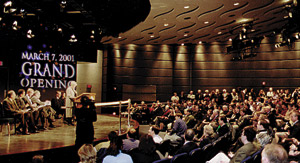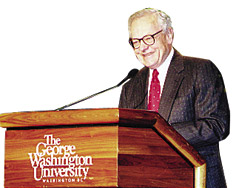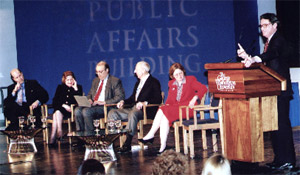|

The opening of GW’s new Media and Public Affairs Building brought together journalistic legends and information-age experts to kick off the University’s giant leap into the world of 21st-century media. Students, faculty, and honored guests enjoyed the moment — which we now present to you.

Amid ruffles, flourishes, and a veritable galaxy of media stars, GW’s new Media and Public Affairs Building held opening festivities March 7 and 8. In a program designed to show off the stunning attributes of the new 142,000-square-foot building, GW began the celebration of its new media center with a traditional ribbon cutting by President Trachtenberg, as well as with building tours and special displays. The six-story red brick and limestone building, located at 805 21st St., N.W., is the new home for the School of Media and Pubic Affairs, the Graduate School of Political Management, the George Washington Institute of Public Policy, Public Administration, The Documentary Center, the Center for Washington Area Studies, and the University Art Gallery.
As part of the opening, the University and the National Press Club co-sponsored a special edition of The Kalb Report on the evening of March 7. Entitled “A Conversation with Bernard Shaw,” the hour-plus program featured tough questions fielded by recently retired CNN news anchor Shaw from host Marvin Kalb and from the audience. Held at the National Press Club and aired live on C-SPAN, the program drew an audience of more than 400 GW students, faculty, and guests, as well as the national television audience.
Participants reconvened at the MPA Building March 8 for speakers and panel discussions. Morning keynote speakers were Bob Schieffer, CBS News Chief Washington Correspondent and Ted Leonsis, Vice Chairman of America Online Inc. CNN’s Wolf Blitzer was the luncheon keynote speaker. One of the panels—“Media and Democracy in the 21st Century”—was moderated by GW’s Carl Stern, Shapiro Professor of Media and Public Affairs. Stern’s panel included such luminaries as Helen Thomas, Richard C. Hottelet, Adam Clayton Powell III, and Jean Folkerts, director of the School of Media and Public Affairs and interim dean of the Columbian School of the Arts and Sciences.
 Local political figures and other dignitaries turned out for opening events, including D.C. city councilmen Jack Evans and Harold Brazil, and GW Board Chair Sheldon Cohen. Board member and art collector Luther W. Brady, M.D., surprised literally everyone when he announced his intention to endow the new University Art Gallery. Local political figures and other dignitaries turned out for opening events, including D.C. city councilmen Jack Evans and Harold Brazil, and GW Board Chair Sheldon Cohen. Board member and art collector Luther W. Brady, M.D., surprised literally everyone when he announced his intention to endow the new University Art Gallery.
Guests and students alike expressed appreciation for the state-of-the-art building, which brings to campus a fiber optic network, Internet access, and cable wiring along with an 80-seat teleconferencing classroom to enhance GW’s distance learning program. The building also boasts a 258-seat auditorium designed and equipped for broadcast and cable events. A modern 1,800-square-foot television studio, plus a flash studio, will enable faculty to participate—without leaving the GW campus—in media interviews beamed worldwide.
Kalb, Shaw, Leonsis, Blitzer, Stern, Thomas, Hottelet……and Schieffer. Bob Schieffer, who this year celebrates his 10th anniversary as host of “Face the Nation,” gave a keynote speech so memorable that it is reproduced in full on the pages that follow. Introducing Schieffer, GW Vice President for Communications and former CBS news executive Michael Freedman noted that “It is absolutely appropriate that on this first morning in the life of an academic center that will train tomorrow’s journalists, we call on a person who today represents the journalistic values of Edward R. Murrow, Dick Hottelet, Robert Trout, Walter Cronkite and CBS News….Bob Schieffer.”

Journalistic Standards in the Information Age
Speech by Bob Schieffer at Opening Ceremonies, Media and Public Affairs Building
Americans should be the most informed people on earth. We have access to more information than any people who have inhabited the Earth at any period in its history. In the age of the 24-hour news cycle, we know about  everything minutes after it happens. We hear about it on the radio, watch it on television, read about it the next day in national newspapers, and talk about it on the Internet. everything minutes after it happens. We hear about it on the radio, watch it on television, read about it the next day in national newspapers, and talk about it on the Internet.
And the result is the first great irony of the Information Age. We are bombarded by so much information from so many sources that sometimes we are numbed by it. Too much news becomes like elevator music: We hear so much we hear nothing. Breaking through all this “news” to report the news is one of journalism’s new challenges.
All of this has taken place in a time of breathtaking technological change.
No one can really say how or by what means Americans will get their news in 10 years or even five. All of us in communications spend a lot of time speculating on the means we will use to deliver the news of the future. In five or 10 years, will Americans get their news from some kind of interactive television or the Internet or some combination of the two? Will the same appliance that brings us sound and picture also print our newspaper? Who can say? All we can say for sure is that all of us will need to get our news from somewhere.
I cite all of the above not to argue that any of it is good or bad, but simply because it IS. This is where we work. Each of the changes I have mentioned merits a lecture of its own, but what I want to talk about today is what has not changed—the role and purpose of the individual reporter.
The medium changes, the technology changes, but the purpose of journalism is no more and no less than what it has always been to get at the truth.
Technological change sometimes causes us to lose sight of that fact.
I remember when television crews covered news events with film cameras. We used videotape only inside the studios. Then one day, the video cameras got small enough to be carried outside, and we wondered if we would need a whole new set of technicians to operate them. At CBS News, we wondered how effective our studio technicians would be, operating in a whole new environment, sunlight. Then we realized the obvious: Of course, videotape was a great technical achievement. Instead of having to wait a half hour to develop a magazine of film, videotape allowed us to play it back instantly. But, beyond that from a journalistic standpoint, it was not the switch from putting an image on tape instead of film that was significant, it was where the camera pointed that was important, the picture that we on the tape, the picture that we decided to use.
|

Carl Stern, GW Shapiro Professor of Media and Public Affairs (at lectern), moderated the March 8 “Media and Democracy in the 21st Century” panel. Participating with Stern were (from left) Bennett Zier, executive vice president of Clear Channel Communications; Helen Thomas, School of Media and Public Affairs (SMPA) Shapiro Fellow and columnist for Hearst Newspapers; Adam Clayton Powell III, vice president of technology and programs for The Freedom Forum; Richard C. Hottelet, legendary CBS News correspondent; and Jean Folkerts, SMPA director and professor, and currently interim dean of the Columbian School of Arts and Sciences. The forum was one of a 2000-01 GW series of “President’s Millennium Seminars.”
|
The technology had changed but the criteria for what makes a good picture had not.
And so, our best film cameramen and our best video people combined forces. The film crews taught the electronic crews about the news, and the electronic cameramen taught the film men about electronics.
In retrospect, it seems obvious that a good photojournalist will get the best pictures whether he or she is exposing videotape or film, but as it always is with new technology, it took us awhile to understand the obvious.
When I was a young reporter I was taught that a successful newspaper gave its readers a combination of what they want to know and ought to know and that’s still not a bad formula. But it is the second part, telling our viewers and readers what they “ought to know” that gives our profession meaning and separates us from the entertainment industry.
In a totalitarian society, the only source of information about the government is the government. A free press provides a second source of information, and if there were no other justification for it, that would be reason enough.
We must be very careful not to appoint ourselves something we are not. We are not the police, nor are we the sole repository of knowledge. We do not have an exclusive franchise on truth or the ability to know it and we are not the only members of society with honorable intentions.
As for the tools at our disposal we must be very careful about using the technology that is available to us. We must drive it and not allow it to drive us. Technology makes it possible to us to produce instant comment. But it does not follow and we should not leave the impression that those who speak first are necessarily right, or that it is possible to find instant answers. In truth, instant answers are seldom found.
In the era of the 24-hour news cycle that demands instant reaction, we often find ourselves seeking out the glib rather that the wise, simply because it is available. This only adds to the false assumption that every problem has an immediate answer, and brings unrealistic pressure on institutions and officials. We should not expect anyone to have all the answers all the time.
Albert Einstein was once asked when he got most of his ideas, the morning or the afternoon. He replied, “I don’t really know. I’ve had only two or three.”
We have an obligation to present all sides of an issue, but it does not follow that every opinion deserves a forum. Some opinions are simply ridiculous and should be dismissed as such. We should recognize that we give limited, short-term credibility to even ridiculous issues when we do provide a forum.
Putting someone on television just because it makes “good television” reduces serious issues to cartoon level and only increases cynicism among our viewers as time goes on.
The 24-hour news cycle has also brought another pressure to journalists: How do we react to a major breaking story when we don’t have all the answers? My answers is, one step at a time. Here’s what I mean. On the night the Supreme Court handed down its decision on who won the presidential race, we had to make a decision. Should we go on the air when the decision was handed down, or only after we were certain what the decision meant? We went on the air immediately. Some criticized us for that and said we should have said, “We’ll be back after we’ve digested this report.” Here’s why we didn’t. This was a momentous case and in this instance, Americans rightly wanted an answer as quickly as possible. In the age of the [remote control] clicker, if we or any other organization had returned to original programming, those who wanted to know the answer would have looked elsewhere. So, we went on the air, as did all the other networks and cable companies, and we basically invited our viewers to watch us as we did what reporters usually do off-camera: try to digest an enormous report and determine what it says. Obviously not every story deserves such treatment but this was of enormous consequence, so I see nothing wrong with that.
But our guideline in every such case must be the same. Be honest with our viewers, and draw no conclusions until we are certain of what we are saying.
I have never felt lonelier than I did that night, standing in front of the Supreme Court In bone-chilling cold and telling Dan Rather and millions of viewers, “Dan, this is 65 pages long, and I can’t say what it means until I read through it.” Of course, what was running through my head was the thought more chilling than the cold: Have they figured this out already at CNN or NBC? Am I the only one that doesn’t know? In fact, we were all struggling that night.
There was no technology to help us. It was just reporters doing what reporters do. But these days, our viewers watch us do it.
In retrospect, I can also say there was no technology helping us on election night either. Which brings me to another point. When we make a mistake we should correct it immediately, no matter how embarrassing. We had a lot to answer for after election night.
When broadcasters were called before Congress to explain what went wrong, members of Congress had every right to ask their questions and level their criticism, but they have no more right to that than any other citizen. In the great scheme of American democracy, we work for the public, not the Congress. Our technology failed us election night, and we must make every effort to correct that—just as strongly as we must always resist government pressure to tell us how to cover the news.
|
CNN’s Larry King was on hand to mark the donation of the Mutual Broadcasting System radio archive by Westwood One Radio Networks. The collection contains thousands of reel-to-reel tapes spanning 50 years of radio broadcasting. It includes close to 30 years of the historic daily news show, “The World Today,” and includes major events such as the Kennedy assassination and the O. J. Simpson trial. The University also received all of Larry King’s Mutual Radio broadcasts, which were the programs that helped propel him to fame. The archive will be kept by the Special Collections division of GW’s Gelman Library.
|
The reason we must correct what happened on election night is this: Our viability rests solely on our credibility. If we are no longer believed we will become irrelevant. That is the great governor on a free press. The Founders understood that in the beginning and the Founders were right.
I have talked about all the technology at our disposal, but I have not yet mentioned what I believe is our most effective tool, the English language.
As journalists whose task is to explain our times, we can take some comfort in what history has demonstrated: That if it is pursued, truth has a way of showing itself, that people do respond to it and that it is possible, when language is properly used, to explain complicated thoughts in ways that people can understand.
I am always appalled to hear the phrase, “words cannot express.” Well, of course they can if we take the time to learn to use them.
Thomas Jefferson sounded the death knell of the divine right of Kings when he wrote the Declaration of Independence and in less than two minutes. With the words he had written on the back of an envelope, Lincoln summarized a civil war that had been 150 years in the making.
In television, we have learned that some pictures require no words. We should also remember that some words require no picture. Has there ever been a picture to match the power of these words: “We hold these truths to be self-evident, that all men are created equal.” Or even three little words, “I love you.”
We marvel at technology that enables us to flash the news from one side of the world to the other. But we sometimes forget that the words of Socrates, Shakespeare, Moses, and Jesus had circled the globe millions upon millions of times before there was a satellite, or a radio, or even a Xerox machine. It was the power of the message that drove them; they needed no technological boost.
With each technological breakthrough, I always remember what Edward R. Murrow used to say: We cannot yet take pictures of the most important thing—ideas, what goes on in the human mind.
Let us remember that, as we dedicate this wonderful new facility. And let us remember that in this constantly and rapidly changing world of communications and of mushrooming corporate bureaucracies brought on by mergers—when it is increasingly difficult to determine who is responsible for what—let us remember that the bedrock of journalism remains what it has always been: the individual journalist’s personal integrity, curiosity, sense of fairness and determination to find the truth, whatever it is.
And let us never forget that our success will rest mainly on our ability to use the language.
To the students who will study here, my best career guidance is to refer to an old novel, Celebrity, written by my late friend Thomas Thompson. In the book, and old city editor asks a young reporter, “Do you want to be good, or just famous?”
To the rest of us, and to the students too, I repeat and commend to you the words of the great Eric Severeid, who said:
“The rules of our profession are self-imposed and few”:
“Not to underestimate the intelligence of the audience or overestimate its information.”
“To elucidate when one can, rather than advocate.”
“To remember always that the public is only people and people only persons, no two alike.”
“To retain the courage of one’s doubts as well as the courage of one’s certainties in this world of dangerously passionate certainties.”
Thank you and congratulations!
|